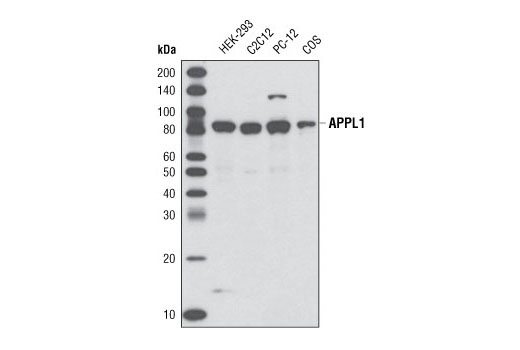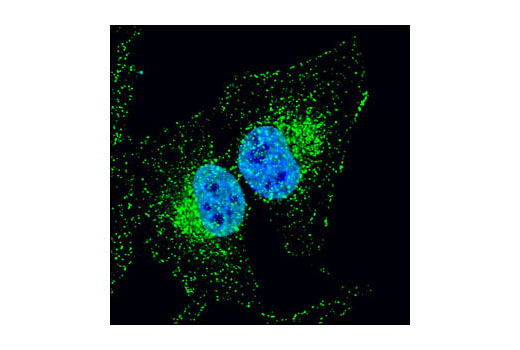WB, IP, IF-IC
H M R Mk
Endogenous
82
Rabbit IgG
#Q9UKG1
26060
Product Information
Product Usage Information
| Application | Dilution |
|---|---|
| Western Blotting | 1:2000 |
| Immunoprecipitation | 1:100 |
| Immunofluorescence (Immunocytochemistry) | 1:100 - 1:400 |
Storage
Specificity / Sensitivity
Species Reactivity:
Human, Mouse, Rat, Monkey
Source / Purification
Monoclonal antibody is produced by immunizing animals with a synthetic peptide corresponding to residues surrounding Thr426 of human APPL1.
Background
The APPL1 multidomain adaptor protein is a BAR-domain protein family member that is involved in membrane trafficking within a number of signal transduction pathways (1). The amino-terminal BAR domain mediates the formation of crescent-shaped APPL1 homodimers (or APPL1 and APPL2 heterodimers) important to lipid binding and membrane curvature sensing (1). The PH domain of APPL1 is required for binding of the adaptor protein to Rab5 GTPase (2). In response to extracellular stimuli, Rab5 GTP hydrolysis releases APPL1 from the endosome and allows translocation of APPL1 to the nucleus where it joins a protein complex that controls chromatin remodeling and gene expression (3). The carboxy-terminal PTB domain of APPL1 enables an interaction between APPL1 and the TrkA neurotrophin receptor. An association between these two proteins and the TrkA-interacting protein GIPC1 within endosomes is required for nerve growth factor mediated signaling (4). APPL1 also binds follicle-stimulating hormone (FSH) receptors, which may provide a relay of FSH signaling to the PI3K/Akt pathway (5). The APPL1 adaptor protein is implicated in insulin signaling, as interaction between APPL1 and Akt2 is required for insulin-stimulated translocation of GLUT4 receptor proteins. Both induced overexpression and knockdown of APPL1 inhibit insulin-stimulated GLUT4 translocation (6). APPL1 binds the adiponectin receptor and acts as a downstream effector in the adiponectin pathway to mediate NO production (7,8). APPL1 interacts with DCC (deleted in colorectal cancer) protein and may play a role in DCC-induced apoptosis (9).
- Habermann, B. (2004) EMBO Rep 5, 250-5.
- Zhu, G. et al. (2007) EMBO J 26, 3484-93.
- Miaczynska, M. et al. (2004) Cell 116, 445-56.
- Lin, D.C. et al. (2006) Mol Cell Biol 26, 8928-41.
- Nechamen, C.A. et al. (2004) Biol Reprod 71, 629-36.
- Saito, T. et al. (2007) J Biol Chem 282, 32280-7.
- Mao, X. et al. (2006) Nat Cell Biol 8, 516-23.
- Cheng, K.K. et al. (2007) Diabetes 56, 1387-94.
- Liu, J. et al. (2002) J Biol Chem 277, 26281-5.
- Hennig, J. et al. (2014) Cell Death Dis 5, e1199.
Species Reactivity
Species reactivity is determined by testing in at least one approved application (e.g., western blot).
Western Blot Buffer
IMPORTANT: For western blots, incubate membrane with diluted primary antibody in 5% w/v BSA, 1X TBS, 0.1% Tween® 20 at 4°C with gentle shaking, overnight.
Applications Key
WB: Western Blotting IP: Immunoprecipitation IF-IC: Immunofluorescence (Immunocytochemistry)
Cross-Reactivity Key
H: human M: mouse R: rat Hm: hamster Mk: monkey Vir: virus Mi: mink C: chicken Dm: D. melanogaster X: Xenopus Z: zebrafish B: bovine Dg: dog Pg: pig Sc: S. cerevisiae Ce: C. elegans Hr: horse GP: Guinea Pig Rab: rabbit All: all species expected
Trademarks and Patents
使用に関する制限
法的な権限を与えられたCSTの担当者が署名した書面によって別途明示的に合意された場合を除き、 CST、その関連会社または代理店が提供する製品には以下の条件が適用されます。お客様が定める条件でここに定められた条件に含まれるものを超えるもの、 または、ここに定められた条件と異なるものは、法的な権限を与えられたCSTの担当者が別途書面にて受諾した場合を除き、拒絶され、 いかなる効力も効果も有しません。
研究専用 (For Research Use Only) またはこれに類似する表示がされた製品は、 いかなる目的についても FDA または外国もしくは国内のその他の規制機関により承認、認可または許可を受けていません。 お客様は製品を診断もしくは治療目的で使用してはならず、また、製品に表示された内容に違反する方法で使用してはなりません。 CST が販売または使用許諾する製品は、エンドユーザーであるお客様に対し、使途を研究および開発のみに限定して提供されるものです。 診断、予防もしくは治療目的で製品を使用することまたは製品を再販売 (単独であるか他の製品等の一部であるかを問いません) もしくはその他の商業的利用の目的で購入することについては、CST から別途許諾を得る必要があります。 お客様は以下の事項を遵守しなければなりません。(a) CST の製品 (単独であるか他の資材と一緒であるかを問いません) を販売、使用許諾、貸与、寄付もしくはその他の態様で第三者に譲渡したり使用させたりしてはなりません。また、商用の製品を製造するために CST の製品を使用してはなりません。(b) 複製、改変、リバースエンジニアリング、逆コンパイル、 分解または他の方法により製品の構造または技術を解明しようとしてはなりません。また、 CST の製品またはサービスと競合する製品またはサービスを開発する目的で CST の製品を使用してはなりません。(c) CST の製品の商標、商号、ロゴ、特許または著作権に関する通知または表示を除去したり改変したりしてはなりません。(d) CST の製品をCST 製品販売条件(CST’s Product Terms of Sale) および該当する書面のみに従って使用しなければなりません。(e) CST の製品に関連してお客様が使用する第三者の製品またはサービスに関する使用許諾条件、 サービス提供条件またはこれに類する合意事項を遵守しなければなりません。


